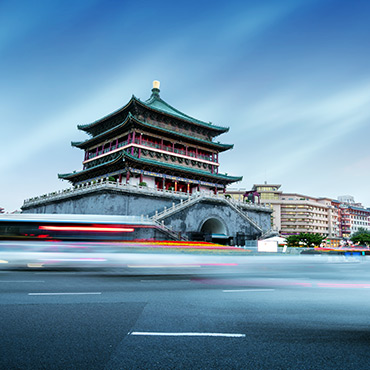Big Wild Goose Pagoda is a famous pagoda in Xi’an. Located at the Da Ci’en Temple in the city’s south, it reaches nearly 65 meters, a remarkable feature, given it was built over 1,300 years ago.
So, why would a westerner visit Big Wild Goose Pagoda? What makes this famous Xi’an pagoda stand out among the many to be discovered in China?
Let’s see if we can clear that up with some insider knowledge about Big Wild Goose Pagoda.
What’s the back story to Big Wild Goose Pagoda?

Big Wild Goose Pagoda was built in 652AD on the same site as another temple.
Back in 648AD, Da Ci’en Temple, which means ‘motherly love and kindness’, was constructed by order of Crown Prince Li Zhi, who later became Emperor Gaozong, third emperor of Tang Dynasty.
Inspiration for the temple came from Li Zhi’s mother, Empress Zhangsun, who died young. The location of Da Ci’en was selected on the basis it would be visible from the emperor’s residence, Hanyuan Palace, and allow him to pay respects to his mother each day.
But Da Ci’en is more of a sideline, rather than the main event at Big Wild Goose Pagoda, so let’s discover why.
What does Monkey King have to do with Big Wild Goose Pagoda?

Every child growing up in China knows Monkey King, and not surprisingly, so do many people from all over the world.
Monkey King’s story – and that of Master Xuanzang – starts with an incredible ‘journey to the West’, that allegedly began in 629 AD when Master Xuanzang traveled to India for the purpose of studying Buddhism.
After 17 years (645 AD), he made his way home with over six hundred Buddhist scriptures in tow, a collection of Buddha statues, and sarira (the sanskrit term for Buddhist relics). On his return, Xuanzang settled in Chang’an city (as Xi’an was known at the time), and was then invited to make Da Ci’en his home. It was here that he began an epic task to translate the Buddhist scriptures.
Clearly an adventurer at heart, Xuanzang’s reputation stems from his adventurous spirit – he traveled to 110 countries – and his seemingly voracious appetite for translation – he is responsible for having translated an amazing 1,330 scriptures into Chinese. It’s any wonder he was considered the greatest scholar of the Tang Dynasty, and his own personal legacy, the Great Tang Records on the Western Regions, captures his remarkable insights as an early pioneer. Due to the voluminous works he translated, Da Ci’en became known as the most significant imperial temple during the Tang dynasty.
So what does an emperor do with all those Buddhist scriptures and treasures? He stores them in a special place fit for treasures. To that end, Master Xuanzang proposed to Emperor Gaozong that a pagoda would be ideal for this purpose, and it seems his enthusiasm carried him over because in 652AD construction on a five storey Indian style pagoda was completed. And while earthquakes, groundwater, and age have contributed to a definite lean that is apparent in the pagoda, it continues to be a Xi’an must-see highlight.
Incredibly, Big Wild Goose Pagoda has been reconstructed several times over a number of dynasties, and has varied in height between nine, ten, and seven storeys. It began leaning to the northwest in 1719 during the Qing dynasty. After the Wenchuan earthquake in 2008, the lean measured just over a meter.
How Big Wild Goose Pagoda was named

Behind the many ancient buildings and monuments in China steeped in legend and history, there is a story to be found, and of course, Big Wild Goose Pagoda does not disappoint. It is said that while he was working on the Great Tang Records of the Western Regions, Master Xuanzang documented a legend involving a pagoda and a wild goose, which he learned Indian monks.
The story goes that Hinayana (meat eating) monks were concerned about their meal because there was no meat. In keeping with their tradition, they prayed to Buddha for meat to cook, at which point a flock of geese appeared. The goose leading the flock fell to the ground and died, providing the monks with their meat.
Naturally, the monks regarded this as a miracle from Buddha and were so deeply touched they became vegetarian. The goose was buried and a pagoda that was built on the site was aptly named Big Wild Goose Pagoda. Master Xuanzang deemed this a fitting tribute to the Buddhist influences and legacy that became home to so many Buddhist scriptures and treasures.
Inside Big Wild Goose Pagoda

Big Wild Goose Pagoda is beautiful, even palatial in design. It follows traditional principles of Chinese architecture , with a single point of access. Notwithstanding the lean, Big Wild Goose Pagoda still offers unique vistas of Xi’an through four arched doors. Take the circular stairway to the top of the pagoda and enjoy viewing the murals throughout, which tell visual stories of Master Xuanzang’s experiences from his travels to India.
Two stone tablets are positioned on either side of the south door on the ground floor. They were completed in 653AD and are regarded as the finest examples of the Tang dynasty’s calligraphic inscriptions. Because two emperors from the Tang dynasty wrote articles about Master Xuanzang, the prime minister, who was also a famous calligraphist at the time of Tang dynasty, scribed the calligraphy for these documents.
Some historians and archaeologists believe there is an underground palace at Big Wild Goose Pagoda where more Buddhist treasures and valuable offerings from the royal family can be found, however this theory hasn’t proven
Is there more to see around the Big Wild Goose Pagoda?

Recognizing the importance of the pagoda, the local government has invested in creating a precinct around the pagoda and broader temple complex.
The Da Ci’en Temple complex is designed in accordance with traditional Chinese architectural style. It includes various halls, bell and drum towers , a vast library for Buddhist texts, Big Wild Goose Pagoda itself, and the Pagodas Forest.
It continues to be a place of learning, with the temple’s monk master delivering lectures on Buddhism most mornings and afternoons. Visitors can hear monks chanting in the courtyard, as well as observe the traditional bell and drum towers that were used in ancient China to signal time. In the morning, the city gate opened after the bell sounded, allowing people to go about their daily life. In the evening, the city gate closed after the drum sound, indicating the start of curfew after which people were required to stay at home.
At the Buddhist temple, it was slightly different. In the morning, the bell is rung first and then followed by the drum, while in the evening, the sounds are made in reverse. The bell is considered to be calming and induce the ideal atmosphere for meditation. The bell is seen as a representation of the sitting Buddha because of its shape. Those who strike the bell make three bows to show their respect.
Looking to capture beautiful travel memories at Big Wild Goose Pagoda? Make your way to either the north or south of the temple complex. It’s here you find perfect settings for photo opportunities. Get snap-happy by day or night, when you take a guided tour. An evening tour is extra special, with the musical fountain show a highlight for visitors.
| Entry Prices | |
|---|---|
| Adults – Temple complex | ¥50 (1 Mar – 31 Oct) ¥40 (1Nov – 28 Feb) |
| Adults – Pagoda | ¥30 |
| Children (6 -18 years old) | half price |
| Children (under 6 years old and under 120cm) | free |
| Food | Yes | Restaurants, cafes, hotels, and shops are located in close proximity to the Big Wild Goose Pagoda |
| Transport | Yes | Bus, subway and taxi |
| Tours | Yes | |
| Family friendly | Yes | |
| Close to city | Yes | |
| Opening hours | Monday – Sunday 8.00am – 6.00pm |




 First Time Traveller 10/10
First Time Traveller 10/10





